BBC Earth newsletter
BBC Earth delivered direct to your inbox
Sign up to receive news, updates and exclusives from BBC Earth and related content from BBC Studios by email.
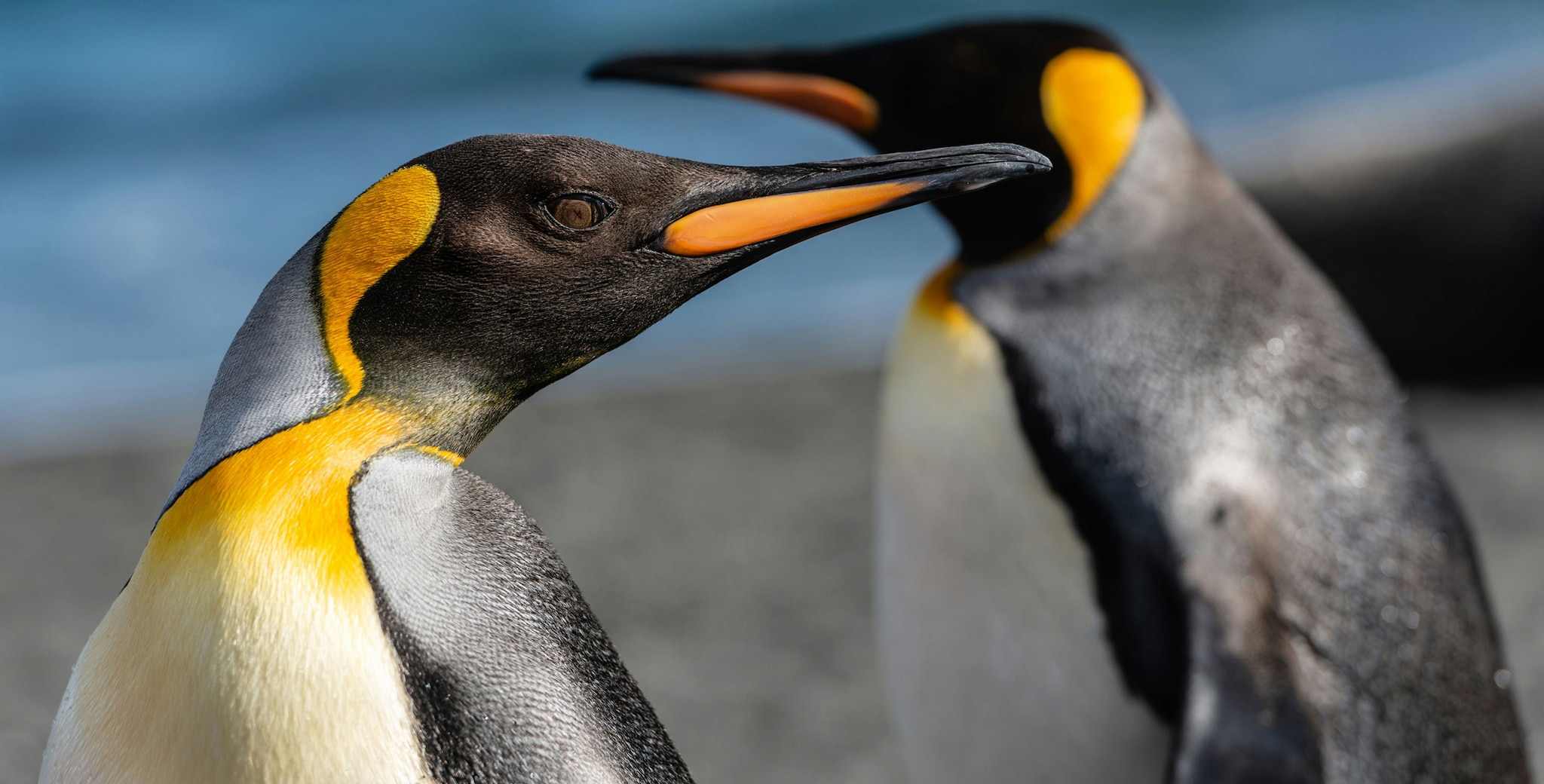
With sophisticated modes of speech, extraordinary displays of parental devotion and an uncanny ability to power nap, the penguin is one our most cherished but endangered birds – and full of surprises.
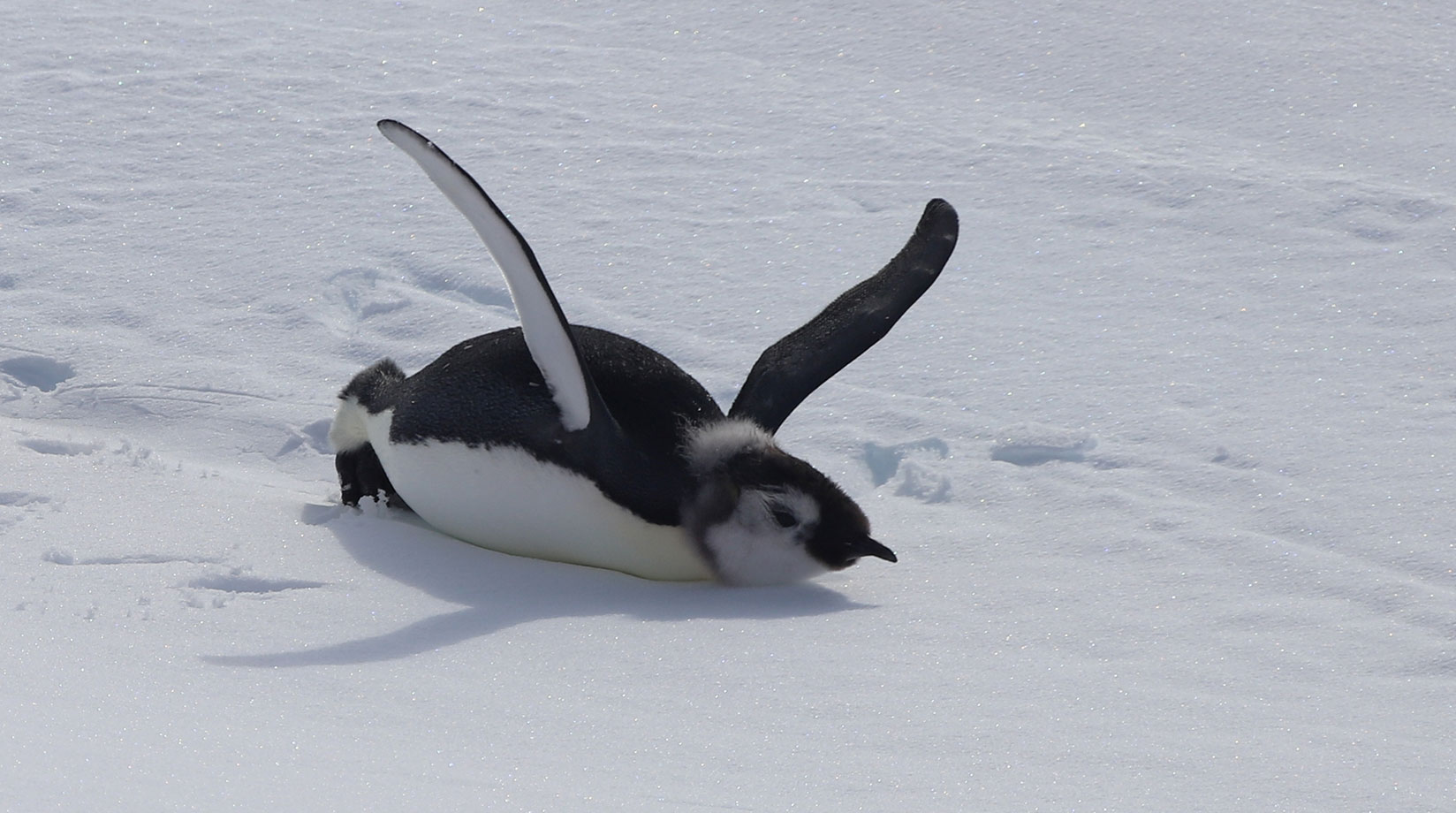
That depends if you believe everything you see on the internet. If you do, then, yes – penguins can fly:
April Fools’ jokes aside, the simple answer is no. Penguins can’t fly. In fact, of the 11,000 known species of birds, only 60 species are flightless and about a third of those are penguins.1 So why have penguins’ wings evolved into flippers rather than flying machines? The deputy leader of Birds, working at the UK’s Whipsnade Zoo, sums it up neatly in this video for BBC Earth: "Penguins have adapted over the years to swim instead of fly."
The science behind the preference for swimming is, perhaps inevitably, constantly evolving. One reason suggested by researchers is that, with a diet consisting largely of sea life and a lack of land-based predators across the majority of penguin habitats, the drive to swim was simply much stronger than the need to fly.2
The theory – supported by key research published in 2023 – goes that as the penguin’s wing evolved for swimming, it became increasingly less suited to flying.3 Most birds have hollow bones, which make them nice and light for flying. But penguins’ bones are exceptionally dense – all the better for swimming and diving, at which the penguin excels.4 Furthermore, rather than keeping their air sacs empty in order to aid aerodynamics, some penguin species fill the extra air sac space with food.5 Great for keeping warm in punishing conditions. Not so good for lift-off.
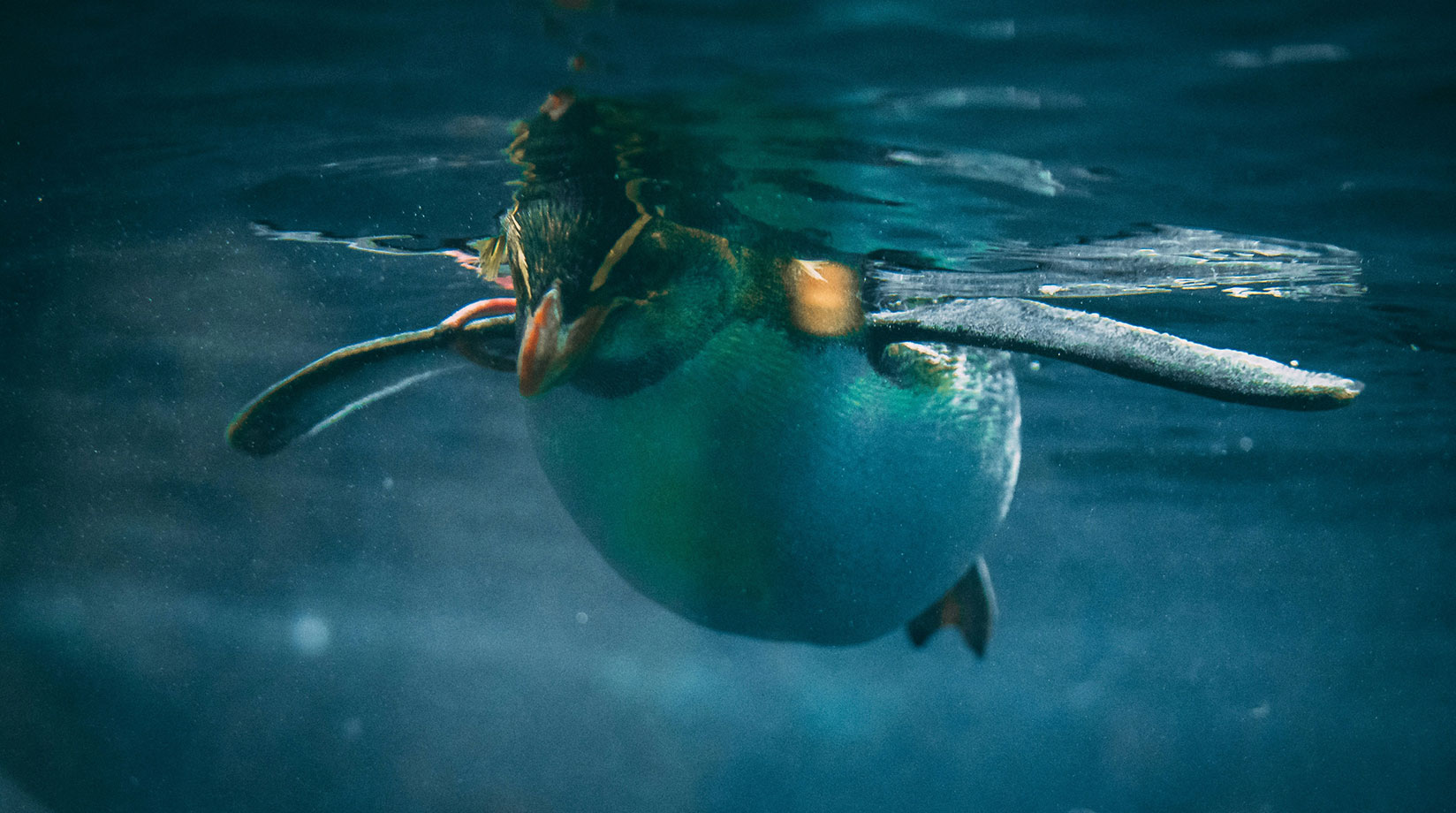
“As the wings became more and more efficient for them to dive, they became less and less efficient for them to fly," says Professor John Speakman, one of the leading academics behind this 2023 research. "At some point, it became so 'expensive' for them to fly that it was better to give up flying altogether and make the wings into small flippers." 6
However, there is one exception to this no-flight rule: the moment penguins reach land. At this point, they launch themselves into the air in a move – brilliantly captured by this WWF photographer – that looks an awful lot like flying:7
As the penguin’s wing evolved for swimming, it became increasingly less suited to flying.
It depends on the species. King and emperor penguins are the least monogamous, with over 80% of king penguins regularly changing partners between breeding seasons.8 At the other end of the spectrum, southern rockhopper penguins reunite with the same female every year and one particularly devoted Magellanic penguin couple stayed together for 16 years.9 However, most penguin couples only stick together during the mating season. For the rest of the time – that’s over 300 days a year – they're in a seriously long-distance relationship, with the couples from one observed southern rockhopper colony reportedly separated, on average, by about 600km.10
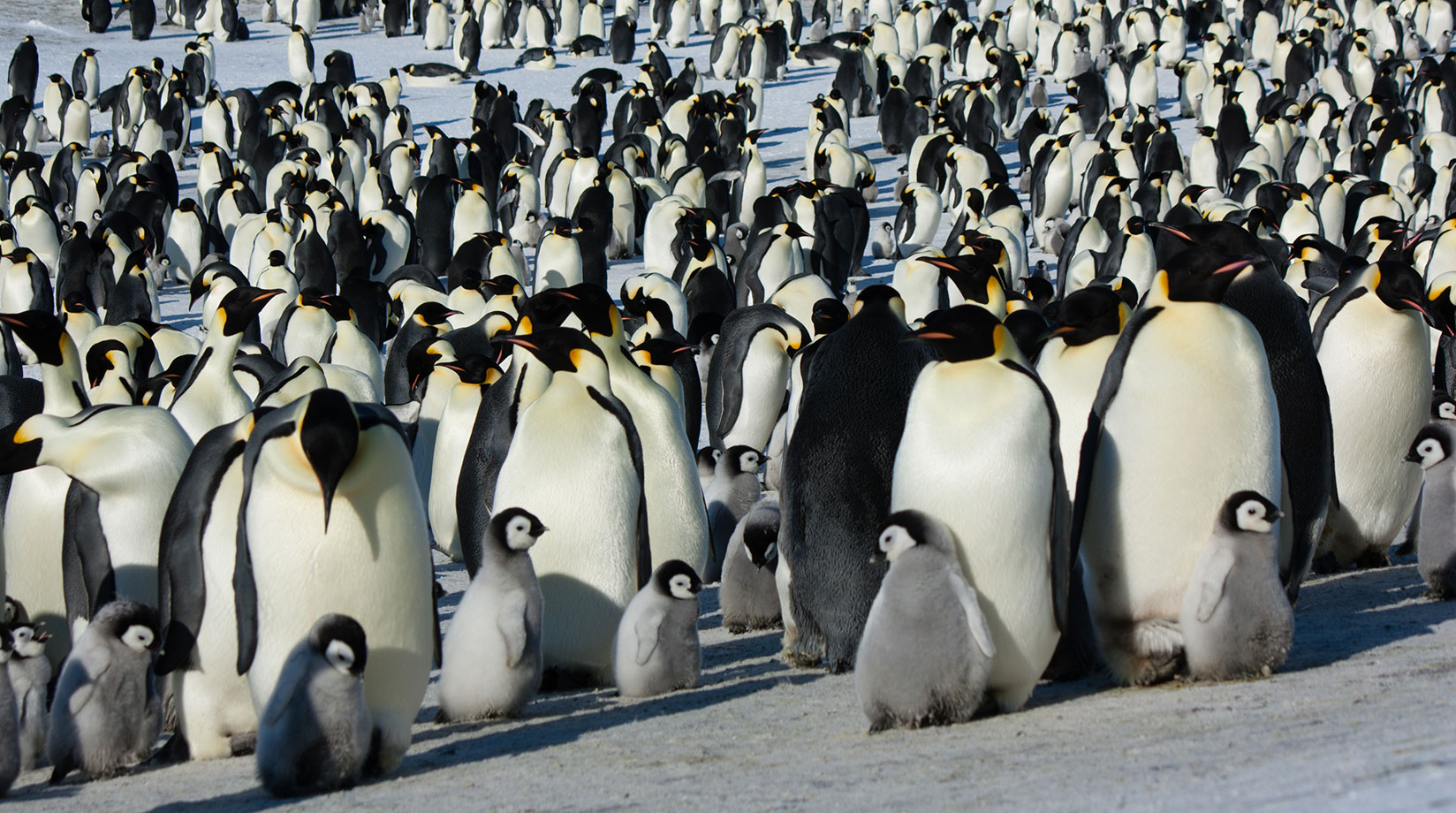
Despite such long-distance relationships and significant divorce rates, many penguin species display extraordinary levels of devotion to their young.11 Thanks to popular films such as Happy Feet and March of the Penguins, the emperor penguin has become one of the most well-known examples of penguin parenting prowess. After the female emperor penguin lays a single egg (that’s just one precious egg in one very cold basket), she heads out to sea to forage for food while the male penguin stays behind to incubate the chick. This involves the dad penguin standing in punishing conditions for weeks, balancing the egg on his feet with the help of a special brood pouch – all while eating nothing and losing more than 20% of his own body weight.12
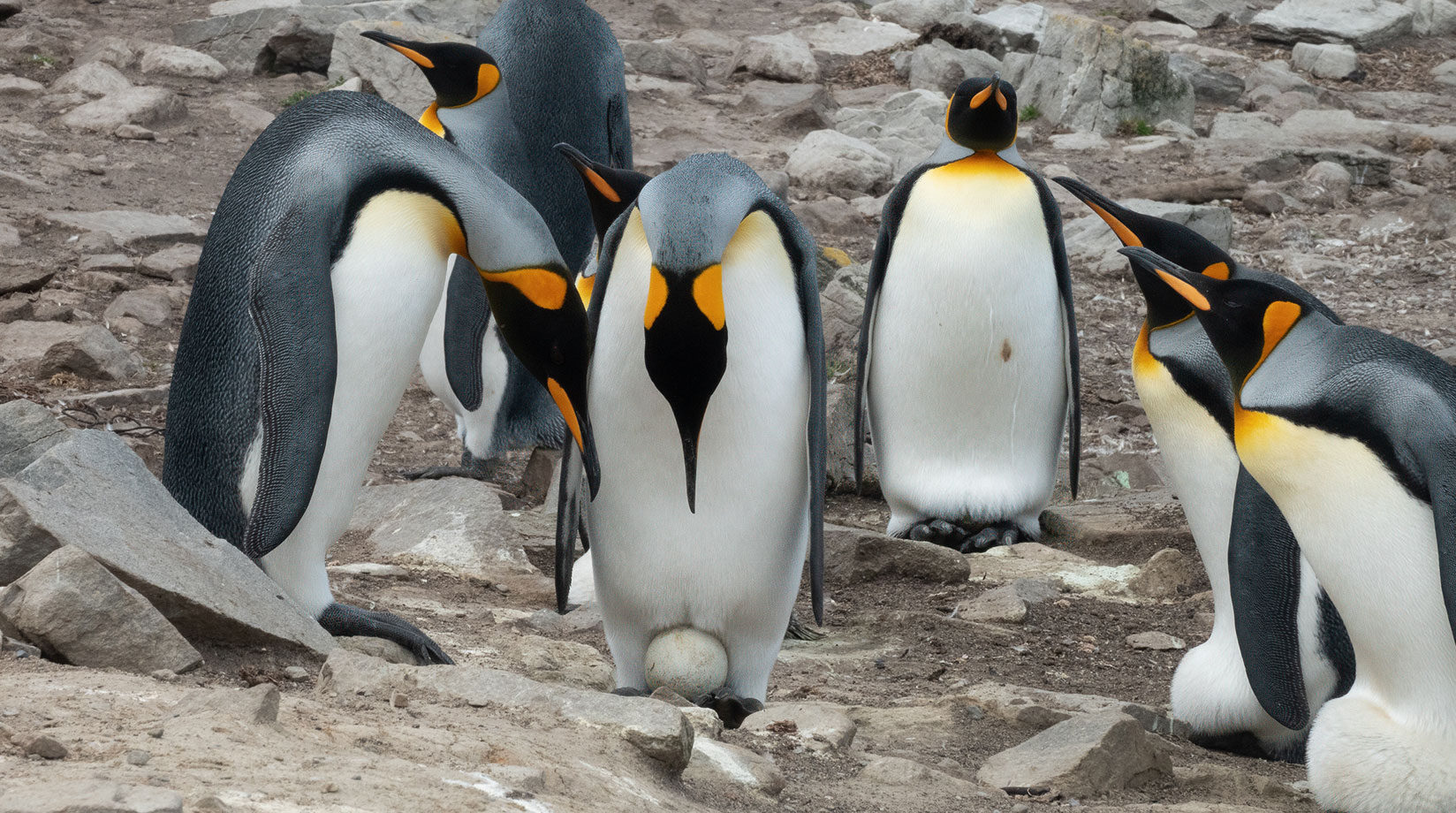
It’s an extraordinary act of parental care, largely governed by powerful hormonal surges.13 In fact, the urge to protect their young is so strong in male emperor penguins that they have been known to incubate some surprising objects – most notably a snowball, captured on film by the BBC Earth team while filming Dynasties.14 How’s that for devotion?
Penguin colonies are not conducive to sleep. They tend to be very large, very smelly and very loud.15
With all that going on, it’s a wonder penguins sleep at all. One species that faces particularly challenging circumstances is the chinstrap penguin, which breeds during the Antarctic summer (with its 24 hours of sunshine) amid some of the planet's busiest and largest penguin colonies.16
With these environmental factors in mind, it’s perhaps no surprise that the chinstrap penguin, like many penguin species, sleeps in short bursts.17 In fact, an important study published in 2023 revealed the chinstrap penguin’s uncanny ability to powernap.18 Conducted on King George Island in Antarctica, the study involved fitting 14 chinstrap penguins with data loggers to measure brain activity, muscle movement and body position. Scientists discovered that while the chinstrap penguin can sleep up to 11 hours a day, this so-called sleep is made up of 10,000 microsleeps. None more than four seconds long. The penguins were even observed dozing while foraging in the sea for food.19
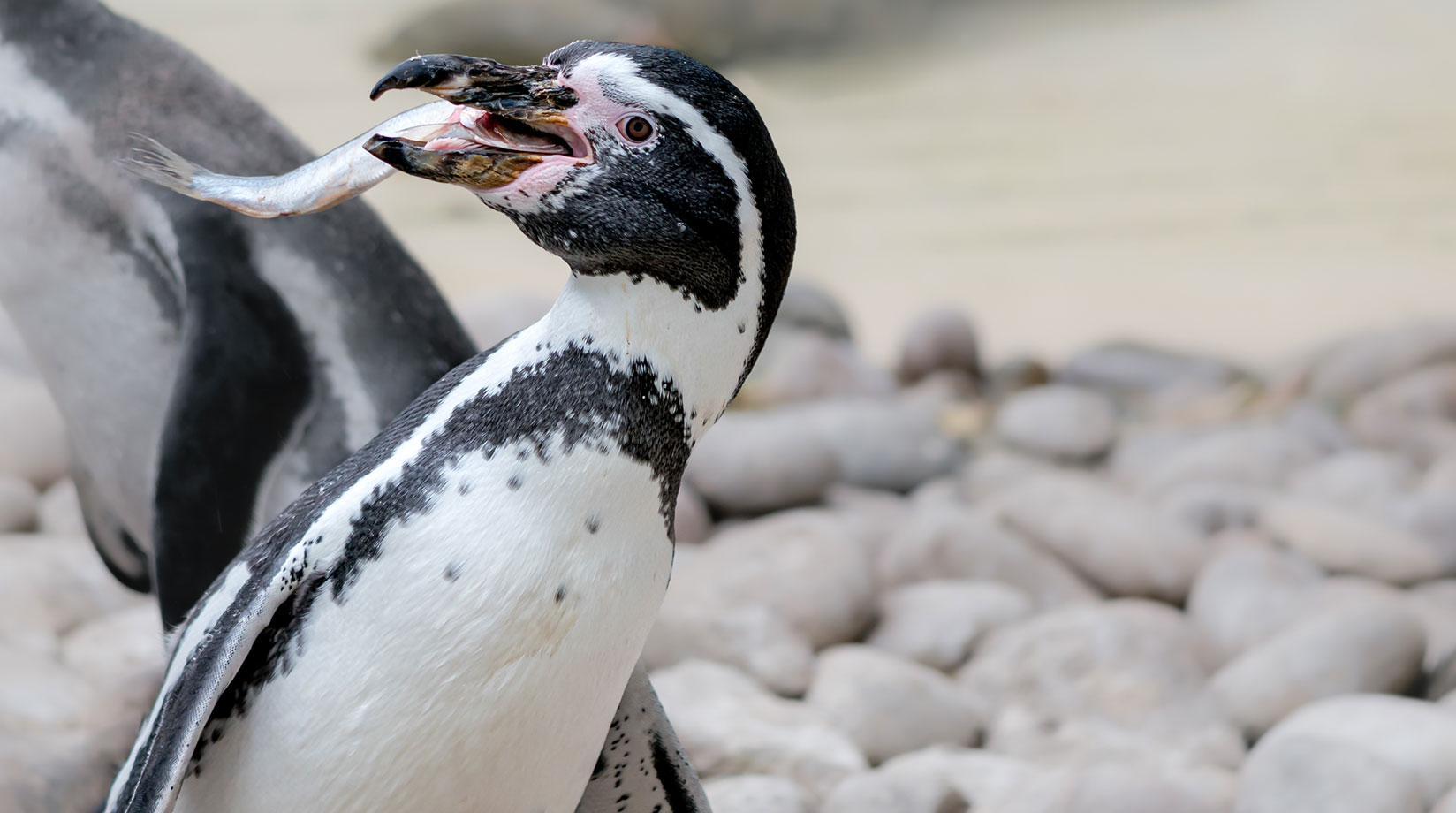
Scientists also discovered that while the recorded sleep was short, it was also deep – with the penguins’ brain wave activity reflecting slow-wave sleep, the deepest sleep possible. So while those naps are exceptionally short, they’re restorative too.20
However, scientists have pointed out that the 2023 sleep study was conducted exclusively across the breeding season.21 Whether penguin’s sleeping habits stay the same at other, less stressful times – and we all know how much parenting can impact our sleep – remains to be seen.
The majority of penguins sound fairly similar to each other and use a range of sounds that have been described as trumpeting, croaking, cackling and cooing.22 However, there are interesting – and even amusing – exceptions among the different penguin species.
One of the most acoustically arresting of the penguins is the jackass penguin, named for its braying call that sounds a bit like a grumpy donkey.23 A fascinating study conducted among 48 African penguins in captivity at Zoom Torino zoo and published in 2014, revealed that those braying sounds are in fact surprisingly complex.24
After recording the African penguins over 104 non-consecutive days and observing the type of behaviour that accompanied each particular call, researchers identified six distinct sounds each with its own purpose: the contact call (short calls expressing isolation from the group); the agonistic call (used during fights and confrontations); ecstatic display song (sung during the mating season); mutual display song (sung while coupled up and nesting); and two different begging calls emitted by chicks to indicate hunger.25 So while penguins might not reach the level of nuance displayed by song birds, they do display – according to lead researcher Dr Livio Favaro – “sophisticated mechanisms to encode information in songs”.26
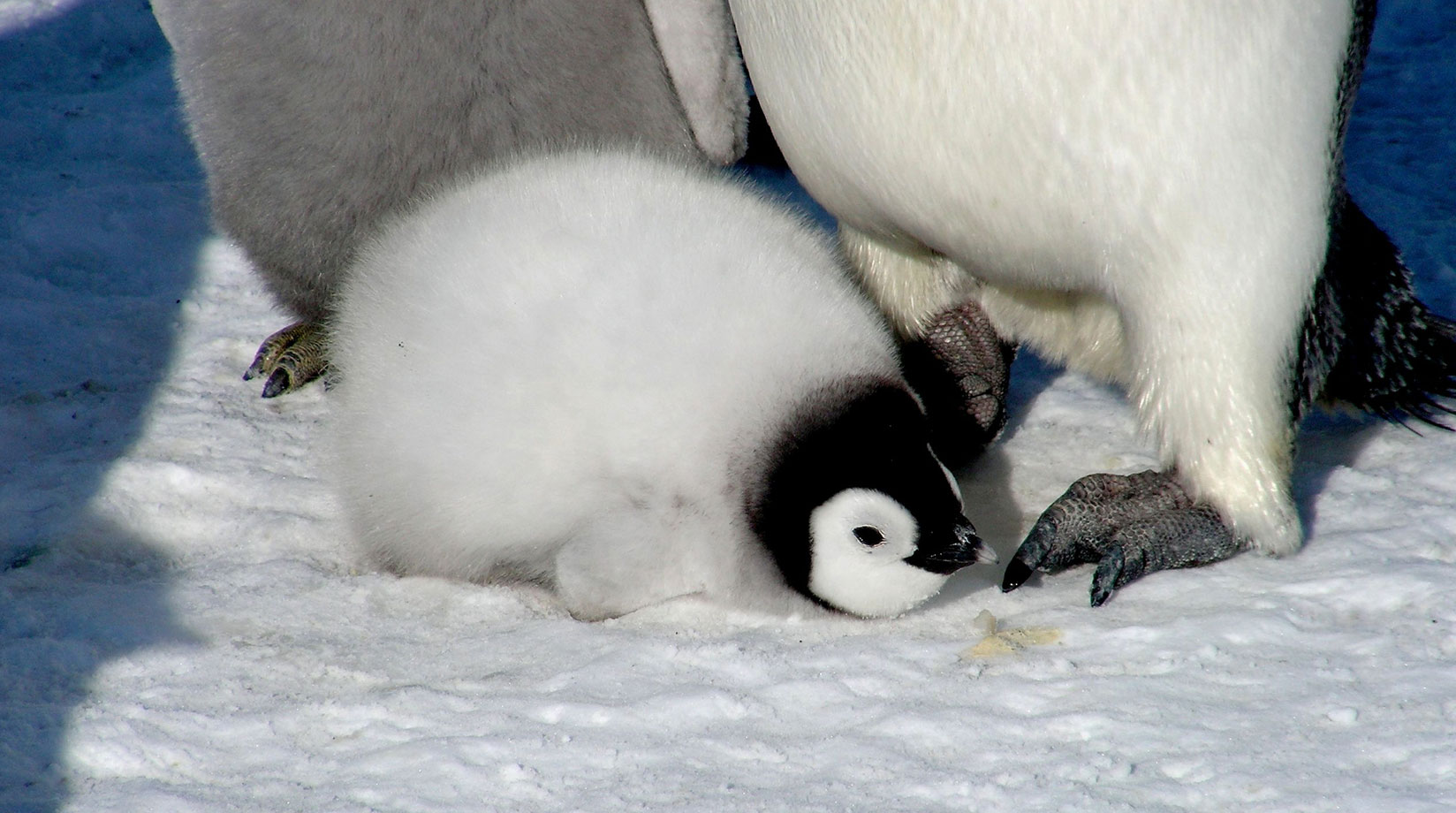
Research published in 2020 contained further linguistic revelations – with the suggestion that some of the penguin’s vocal patterns follow the same principles as human linguistics.27 After analysing 590 ecstatic display songs from 28 adult African penguins across a range of Italian zoos, researchers discovered the penguins’ calls obeyed two linguistic laws also used by humans.28 In essence, the laws state that the most frequently used sounds tend to be shorter (Zipf’s law of brevity) and that the longer the call, the shorter the sounds contained within it (Menzerath-Atlmann law).29 It’s the first time these linguistic laws have been observed in non-primates and, according to researchers, all boils down to a drive towards efficiency – with the compression of information conserving precious energy.30
Other species reveal more linguistic surprises. The Adélie penguin must make itself heard amid some of biggest and noisiest penguin colonies in the world – with one colony on Danger Islands, off the northernmost tip of the Antarctic Peninsula, containing around 1.5 million penguins.31 These remote colonies are notoriously hard to access but, if you somehow made it to the furthest reaches of the Antarctic, you’d be hit with the deafening clamour of the adult Adélie’s primary call; ‘arr-rar-rar-rar-raaah’, followed by a reverberating ‘kug-gu-gu-gu-gaaa’.32
During the mating season, the nature of that sound shifts and the males serenade the females with an ecstatic display call, which according to researcher Emma Marks, sounds like a "cross between a donkey and a stalled car".33 According to a study published in 2010 and conducted among Adélie penguins breeding on Antarctica’s remote Ross Island, the males with the more consistent pitch are among the first to acquire a mate. Scientists believe this is because a steady sound correlates with a fatter voice box, and thus a stronger and healthier male penguin and all-round more promising mate. Less speed dating then. More sound dating.
Featured image © Paul Carrol | Unsplash
Fun fact image © roger ARPS BPE1 CPAGB | Shutterstock
Quick Facts:
1. “HOME.” IUCN Penguin, www.penguinsg.org/.
2. International, Penguins. What Do You Call a Group of Penguins | Penguins International. 17 Nov. 2020, www.penguinsinternational.org/what-do-you-call-a-group-of-penguins/.
3. “Penguins - British Antarctic Survey.” Bas.ac.uk, 2015, www.bas.ac.uk/about/antarctica/wildlife/penguins/;
Prevost, Jean, and Frank Gill. “Penguin | Features, Habitat, & Facts.” Encyclopædia Britannica, 18 Apr. 2019, www.britannica.com/animal/penguin. Accessed 13 May 2019.
4. “How Long Do Penguins Live? (Complete Guide).” Birdfact, craftcms-tailwind, 2022, birdfact.com/articles/how-long-do-penguins-live#whatIsTheTypicalLifespanOfPenguins. Accessed 19 Nov. 2024.
5. “Penguins.” BirdLife International, 15 June 2021, www.birdlife.org/birds/penguins/;
6. “Little Penguin.” Penguin Foundation, penguinfoundation.org.au/about-us/species/little-penguin;
National Geographic. “Emperor Penguin | National Geographic.” Animals, National Geographic, 10 June 2011, www.nationalgeographic.com/animals/birds/facts/emperor-penguin.
7. “Penguin.” Britannica Kids, kids.britannica.com/kids/article/penguin/353611.
8. “Penguins - British Antarctic Survey.” Bas.ac.uk, 2015, www.bas.ac.uk/about/antarctica/wildlife/penguins/.
9. “The IUCN Red List of Threatened Species.” IUCN Red List of Threatened Species, Name, 2024, www.iucnredlist.org/search/list?query=penguin&searchType=species. Accessed 19 Nov. 2024.
Fact file:
1. Platt, James. Why Don’t Penguins Fly? | Penguins International. 4 Nov. 2019, www.penguinsinternational.org/why-dont-penguins-fly/.
2. Platt, James. Why Don’t Penguins Fly? | Penguins International. 4 Nov. 2019, www.penguinsinternational.org/why-dont-penguins-fly/.
3. Elliott, Kyle H., et al. “High Flight Costs, but Low Dive Costs, in Auks Support the Biomechanical Hypothesis for Flightlessness in Penguins.” Proceedings of the National Academy of Sciences, vol. 110, no. 23, 20 May 2013, pp. 9380–9384, https://doi.org/10.1073/pnas.1304838110. Accessed 9 Aug. 2020.
4. Sian Liversage. “How Do Penguins Swim so Well?” Penguins International, 24 Feb. 2020, www.penguinsinternational.org/how-do-penguins-swim-so-well/.
5. Platt, James. Why Don’t Penguins Fly? | Penguins International. 4 Nov. 2019, www.penguinsinternational.org/why-dont-penguins-fly/.
6. Morelle, Rebecca. “Puzzle of Why Penguin Cannot Fly “Solved.”” BBC News, 20 May 2013, www.bbc.co.uk/news/science-environment-22601223.
7. “Flying Penguin | Magazine Articles | WWF.” World Wildlife Fund, 2014, www.worldwildlife.org/magazine/issues/winter-2014/articles/flying-pengu…. Accessed 19 Nov. 2024.
8. Aranzamendi, Nataly H. Divorcing Penguins - Not All Penguins Stay Together for Life | Penguins International. 28 Jan. 2019, www.penguinsinternational.org/divorcing-penguins/.
9. Shultz, David. ““Monogamous” Penguins Spend Most of Their Year Apart.” Science, 8 Sept. 2015, https://doi.org/10.1126/science.aad1726;
Farhoud, Nada. “Love Birds: A Pair of Romantic Penguins Have Stayed Together for a Record 16 Years.” The Mirror, 24 Nov. 2012, www.mirror.co.uk/news/weird-news/penguin-lovers-together-for-a-record-1…. Accessed 19 Nov. 2024;
Borboroglu, Pablo Garcia, and P. Dee Boersma. Penguins: Natural History and Conservation. JSTOR, University of Washington Press, 2013, www.jstor.org/stable/j.ctvd7w7v0.
10. Penguins: Natural History and Conservation. JSTOR, University of Washington Press, 2013, www.jstor.org/stable/j.ctvd7w7v0.
11. “Monogamous” Penguins Spend Most of Their Year Apart.” Science, 8 Sept. 2015, https://doi.org/10.1126/science.aad1726. Accessed 8 Sept. 2019.
12. Choudhury, S. (1995). Divorce in birds: a review of the hypotheses. Animal Behaviour, 50(2), 413-429;
“Penguins - British Antarctic Survey.” Bas.ac.uk, 2015, www.bas.ac.uk/about/antarctica/wildlife/penguins/;
Williams, Emma. “Penguins and Their Chicks: Super-Parents | Penguins International.” Penguins International, 14 Aug. 2019, www.penguinsinternational.org/penguin-parenting-super-parents/.
13. “Penguins and Their Chicks: Super-Parents | Penguins International.” Penguins International, 14 Aug. 2019, www.penguinsinternational.org/penguin-parenting-super-parents/.
14. Center, Synthesis. “Penguin Males with Steady Pitch Make Better Parents (W/ Audio).” Phys.org, 12 July 2010, phys.org/news/2010-07-penguin-males-steady-pitch-parents.html. Accessed 19 Nov. 2024.
15. “A 4-Second Power Nap? These Penguin Parents Survive on “Microsleeps.”” Animals, 30 Nov. 2023, www.nationalgeographic.com/animals/article/chinstrap-penguins-parents-n….
16. “Chinstrap Penguin.” British Antarctic Survey, www.bas.ac.uk/about/antarctica/wildlife/penguins/chinstrap-penguin/;
National Geographic. “Chinstrap Penguin Facts.” Animals, 13 Dec. 2018, www.nationalgeographic.com/animals/birds/facts/chinstrap-penguin.
17. Weston, Phoebe. “10,000 Naps a Day: How Chinstrap Penguins Survive on Microsleeps.” The Guardian, The Guardian, 30 Nov. 2023, www.theguardian.com/environment/2023/nov/30/rough-sleepers-how-chinstra…. Accessed 19 Nov. 2024.
18, 19. 20. Cummings, Sean. “This Antarctic Penguin Sleeps 11 Hours a Day—a Few Seconds at a Time.” Science.org, 30 Nov. 2023, www.science.org/content/article/antarctic-penguin-sleeps-11-hours-day-f….
21. “A 4-Second Power Nap? These Penguin Parents Survive on “Microsleeps.”” Animals, 30 Nov. 2023, www.nationalgeographic.com/animals/article/chinstrap-penguins-parents-n….
22. Davis, Nicola. “Jackass Penguin Call Shares Traits of Human Speech, Scientists Say.” The Guardian, The Guardian, 5 Feb. 2020, www.theguardian.com/science/2020/feb/05/jackass-penguin-call-shares-tra…. Accessed 19 Nov. 2024.
23. “The Vocal Repertoire of the African Penguin (Spheniscus Demersus): Structure and Function of Calls.” PLoS ONE, vol. 9, no. 7, 30 July 2014, p. e103460, https://doi.org/10.1371/journal.pone.0103460.
24. Nishad Karim. “Secret Language of Penguins Decoded.” The Guardian, The Guardian, 30 July 2014, www.theguardian.com/science/2014/jul/30/african-jackass-penguins-calls.
25. “The Vocal Repertoire of the African Penguin (Spheniscus Demersus): Structure and Function of Calls.” PLoS ONE, vol. 9, no. 7, 30 July 2014, p. e103460, https://doi.org/10.1371/journal.pone.0103460.
26. Favaro, Livio, et al. “Do Penguins’ Vocal Sequences Conform to Linguistic Laws?” Biology Letters, vol. 16, no. 2, Feb. 2020, p. 20190589, https://doi.org/10.1098/rsbl.2019.0589.
27. “Penguin Speech Follows Human Language Rules.” Sciencefocus.com, 2020, www.sciencefocus.com/news/penguin-speech-follows-human-language-rules. Accessed 19 Nov. 2024.
28. Yirka, Bob. “Penguin Calls Found to Conform to Human Linguistic Laws.” Phys.org, 5 Feb. 2020, phys.org/news/2020-02-penguin-conform-human-linguistic-laws.html. Accessed 19 Nov. 2024;
“Jackass Penguin Call Shares Traits of Human Speech, Scientists Say.” The Guardian, The Guardian, 5 Feb. 2020, www.theguardian.com/science/2020/feb/05/jackass-penguin-call-shares-tra….
29. Wu, Katherine J. “Jackass Penguin Calls Follow Similar Rules to Human Speech.” Smithsonian Magazine, 6 Feb. 2020, www.smithsonianmag.com/smart-news/jackass-penguin-calls-follow-similar-…. Accessed 19 Nov. 2024.
30. Trevino, Julissa. “Scientists Discover “Super-Colony” of 1.5 Million Adélie Penguins in Images from Space.” Smithsonian Magazine, 2 Mar. 2018, www.smithsonianmag.com/smart-news/adelie-penguin-super-colony-found-aft…. Accessed 19 Nov. 2024.
31. “Adelie Penguin | New Zealand Birds Online.” Www.nzbirdsonline.org.nz, www.nzbirdsonline.org.nz/species/adelie-penguin.
32. Brunton, Dianne, et al. “Ecstatic Display Calls of the Adélie Penguin Honestly Predict Male Condition and Breeding Success.” Behaviour, vol. 147, no. 2, 2010, pp. 165–184, https://doi.org/10.1163/000579509x12512863752751.
33. “Penguin Males with Steady Pitch Make Better Parents (W/ Audio).” Phys.org, 12 July 2010, phys.org/news/2010-07-penguin-males-steady-pitch-parents.html.
With sophisticated modes of speech, extraordinary displays of parental devotion and an uncanny ability to power nap, the penguin is one our most cherished but endangered birds – and full of surprises.
Chick, nestling
ent. On land and on the move: waddle. Congregated for breeding: colony or rookery. In the water: raft. A group of chicks: crèche2
A large range of seafood including fish, squid, crustaceans.4
Healthy adult penguins tend to live in areas free of predators, but in water penguins are hunted by leopard seals, killer whales and sharks, and chicks and eggs can be preyed on by a large range of animals (depending on species and habitat) including a number of seabirds, snakes, cats and rats.3
Species dependent – with a life expectancy from as little as six years (the little penguin) up to 30 years (Magellanic penguin) Many live for around 15 – 20 years4
33cm - 1m+5
From less than 1kg (little penguin) to 40kg (emperor penguin), i.e. anywhere from the size of a cabbage to a labrador retriever dog6
Southern Hemisphere. Some species are found in Antarctica or on nearby islands. Penguins also live along the coasts of Africa, New Zealand, Australia and South America, and the Galápagos penguin lives at the equator, off the coast of Ecuador7
Total number of breeding pairs is estimated at around 20 million8
One of the most threatened groups of seabirds – with half of the 18 species listed as Vulnerable or Endangered9
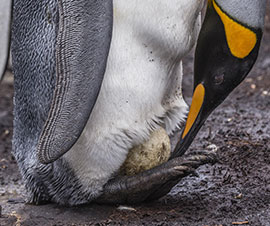
While incubating an egg, the male emperor penguin eats nothing and can lose over 20% of his weight.

That depends if you believe everything you see on the internet. If you do, then, yes – penguins can fly:
April Fools’ jokes aside, the simple answer is no. Penguins can’t fly. In fact, of the 11,000 known species of birds, only 60 species are flightless and about a third of those are penguins.1 So why have penguins’ wings evolved into flippers rather than flying machines? The deputy leader of Birds, working at the UK’s Whipsnade Zoo, sums it up neatly in this video for BBC Earth: "Penguins have adapted over the years to swim instead of fly."
The science behind the preference for swimming is, perhaps inevitably, constantly evolving. One reason suggested by researchers is that, with a diet consisting largely of sea life and a lack of land-based predators across the majority of penguin habitats, the drive to swim was simply much stronger than the need to fly.2
The theory – supported by key research published in 2023 – goes that as the penguin’s wing evolved for swimming, it became increasingly less suited to flying.3 Most birds have hollow bones, which make them nice and light for flying. But penguins’ bones are exceptionally dense – all the better for swimming and diving, at which the penguin excels.4 Furthermore, rather than keeping their air sacs empty in order to aid aerodynamics, some penguin species fill the extra air sac space with food.5 Great for keeping warm in punishing conditions. Not so good for lift-off.

“As the wings became more and more efficient for them to dive, they became less and less efficient for them to fly," says Professor John Speakman, one of the leading academics behind this 2023 research. "At some point, it became so 'expensive' for them to fly that it was better to give up flying altogether and make the wings into small flippers." 6
However, there is one exception to this no-flight rule: the moment penguins reach land. At this point, they launch themselves into the air in a move – brilliantly captured by this WWF photographer – that looks an awful lot like flying:7
As the penguin’s wing evolved for swimming, it became increasingly less suited to flying.
It depends on the species. King and emperor penguins are the least monogamous, with over 80% of king penguins regularly changing partners between breeding seasons.8 At the other end of the spectrum, southern rockhopper penguins reunite with the same female every year and one particularly devoted Magellanic penguin couple stayed together for 16 years.9 However, most penguin couples only stick together during the mating season. For the rest of the time – that’s over 300 days a year – they're in a seriously long-distance relationship, with the couples from one observed southern rockhopper colony reportedly separated, on average, by about 600km.10

Despite such long-distance relationships and significant divorce rates, many penguin species display extraordinary levels of devotion to their young.11 Thanks to popular films such as Happy Feet and March of the Penguins, the emperor penguin has become one of the most well-known examples of penguin parenting prowess. After the female emperor penguin lays a single egg (that’s just one precious egg in one very cold basket), she heads out to sea to forage for food while the male penguin stays behind to incubate the chick. This involves the dad penguin standing in punishing conditions for weeks, balancing the egg on his feet with the help of a special brood pouch – all while eating nothing and losing more than 20% of his own body weight.12

It’s an extraordinary act of parental care, largely governed by powerful hormonal surges.13 In fact, the urge to protect their young is so strong in male emperor penguins that they have been known to incubate some surprising objects – most notably a snowball, captured on film by the BBC Earth team while filming Dynasties.14 How’s that for devotion?
Penguin colonies are not conducive to sleep. They tend to be very large, very smelly and very loud.15
With all that going on, it’s a wonder penguins sleep at all. One species that faces particularly challenging circumstances is the chinstrap penguin, which breeds during the Antarctic summer (with its 24 hours of sunshine) amid some of the planet's busiest and largest penguin colonies.16
With these environmental factors in mind, it’s perhaps no surprise that the chinstrap penguin, like many penguin species, sleeps in short bursts.17 In fact, an important study published in 2023 revealed the chinstrap penguin’s uncanny ability to powernap.18 Conducted on King George Island in Antarctica, the study involved fitting 14 chinstrap penguins with data loggers to measure brain activity, muscle movement and body position. Scientists discovered that while the chinstrap penguin can sleep up to 11 hours a day, this so-called sleep is made up of 10,000 microsleeps. None more than four seconds long. The penguins were even observed dozing while foraging in the sea for food.19

Scientists also discovered that while the recorded sleep was short, it was also deep – with the penguins’ brain wave activity reflecting slow-wave sleep, the deepest sleep possible. So while those naps are exceptionally short, they’re restorative too.20
However, scientists have pointed out that the 2023 sleep study was conducted exclusively across the breeding season.21 Whether penguin’s sleeping habits stay the same at other, less stressful times – and we all know how much parenting can impact our sleep – remains to be seen.
The majority of penguins sound fairly similar to each other and use a range of sounds that have been described as trumpeting, croaking, cackling and cooing.22 However, there are interesting – and even amusing – exceptions among the different penguin species.
One of the most acoustically arresting of the penguins is the jackass penguin, named for its braying call that sounds a bit like a grumpy donkey.23 A fascinating study conducted among 48 African penguins in captivity at Zoom Torino zoo and published in 2014, revealed that those braying sounds are in fact surprisingly complex.24
After recording the African penguins over 104 non-consecutive days and observing the type of behaviour that accompanied each particular call, researchers identified six distinct sounds each with its own purpose: the contact call (short calls expressing isolation from the group); the agonistic call (used during fights and confrontations); ecstatic display song (sung during the mating season); mutual display song (sung while coupled up and nesting); and two different begging calls emitted by chicks to indicate hunger.25 So while penguins might not reach the level of nuance displayed by song birds, they do display – according to lead researcher Dr Livio Favaro – “sophisticated mechanisms to encode information in songs”.26

Research published in 2020 contained further linguistic revelations – with the suggestion that some of the penguin’s vocal patterns follow the same principles as human linguistics.27 After analysing 590 ecstatic display songs from 28 adult African penguins across a range of Italian zoos, researchers discovered the penguins’ calls obeyed two linguistic laws also used by humans.28 In essence, the laws state that the most frequently used sounds tend to be shorter (Zipf’s law of brevity) and that the longer the call, the shorter the sounds contained within it (Menzerath-Atlmann law).29 It’s the first time these linguistic laws have been observed in non-primates and, according to researchers, all boils down to a drive towards efficiency – with the compression of information conserving precious energy.30
Other species reveal more linguistic surprises. The Adélie penguin must make itself heard amid some of biggest and noisiest penguin colonies in the world – with one colony on Danger Islands, off the northernmost tip of the Antarctic Peninsula, containing around 1.5 million penguins.31 These remote colonies are notoriously hard to access but, if you somehow made it to the furthest reaches of the Antarctic, you’d be hit with the deafening clamour of the adult Adélie’s primary call; ‘arr-rar-rar-rar-raaah’, followed by a reverberating ‘kug-gu-gu-gu-gaaa’.32
During the mating season, the nature of that sound shifts and the males serenade the females with an ecstatic display call, which according to researcher Emma Marks, sounds like a "cross between a donkey and a stalled car".33 According to a study published in 2010 and conducted among Adélie penguins breeding on Antarctica’s remote Ross Island, the males with the more consistent pitch are among the first to acquire a mate. Scientists believe this is because a steady sound correlates with a fatter voice box, and thus a stronger and healthier male penguin and all-round more promising mate. Less speed dating then. More sound dating.
Featured image © Paul Carrol | Unsplash
Fun fact image © roger ARPS BPE1 CPAGB | Shutterstock
Quick Facts:
1. “HOME.” IUCN Penguin, www.penguinsg.org/.
2. International, Penguins. What Do You Call a Group of Penguins | Penguins International. 17 Nov. 2020, www.penguinsinternational.org/what-do-you-call-a-group-of-penguins/.
3. “Penguins - British Antarctic Survey.” Bas.ac.uk, 2015, www.bas.ac.uk/about/antarctica/wildlife/penguins/;
Prevost, Jean, and Frank Gill. “Penguin | Features, Habitat, & Facts.” Encyclopædia Britannica, 18 Apr. 2019, www.britannica.com/animal/penguin. Accessed 13 May 2019.
4. “How Long Do Penguins Live? (Complete Guide).” Birdfact, craftcms-tailwind, 2022, birdfact.com/articles/how-long-do-penguins-live#whatIsTheTypicalLifespanOfPenguins. Accessed 19 Nov. 2024.
5. “Penguins.” BirdLife International, 15 June 2021, www.birdlife.org/birds/penguins/;
6. “Little Penguin.” Penguin Foundation, penguinfoundation.org.au/about-us/species/little-penguin;
National Geographic. “Emperor Penguin | National Geographic.” Animals, National Geographic, 10 June 2011, www.nationalgeographic.com/animals/birds/facts/emperor-penguin.
7. “Penguin.” Britannica Kids, kids.britannica.com/kids/article/penguin/353611.
8. “Penguins - British Antarctic Survey.” Bas.ac.uk, 2015, www.bas.ac.uk/about/antarctica/wildlife/penguins/.
9. “The IUCN Red List of Threatened Species.” IUCN Red List of Threatened Species, Name, 2024, www.iucnredlist.org/search/list?query=penguin&searchType=species. Accessed 19 Nov. 2024.
Fact file:
1. Platt, James. Why Don’t Penguins Fly? | Penguins International. 4 Nov. 2019, www.penguinsinternational.org/why-dont-penguins-fly/.
2. Platt, James. Why Don’t Penguins Fly? | Penguins International. 4 Nov. 2019, www.penguinsinternational.org/why-dont-penguins-fly/.
3. Elliott, Kyle H., et al. “High Flight Costs, but Low Dive Costs, in Auks Support the Biomechanical Hypothesis for Flightlessness in Penguins.” Proceedings of the National Academy of Sciences, vol. 110, no. 23, 20 May 2013, pp. 9380–9384, https://doi.org/10.1073/pnas.1304838110. Accessed 9 Aug. 2020.
4. Sian Liversage. “How Do Penguins Swim so Well?” Penguins International, 24 Feb. 2020, www.penguinsinternational.org/how-do-penguins-swim-so-well/.
5. Platt, James. Why Don’t Penguins Fly? | Penguins International. 4 Nov. 2019, www.penguinsinternational.org/why-dont-penguins-fly/.
6. Morelle, Rebecca. “Puzzle of Why Penguin Cannot Fly “Solved.”” BBC News, 20 May 2013, www.bbc.co.uk/news/science-environment-22601223.
7. “Flying Penguin | Magazine Articles | WWF.” World Wildlife Fund, 2014, www.worldwildlife.org/magazine/issues/winter-2014/articles/flying-pengu…. Accessed 19 Nov. 2024.
8. Aranzamendi, Nataly H. Divorcing Penguins - Not All Penguins Stay Together for Life | Penguins International. 28 Jan. 2019, www.penguinsinternational.org/divorcing-penguins/.
9. Shultz, David. ““Monogamous” Penguins Spend Most of Their Year Apart.” Science, 8 Sept. 2015, https://doi.org/10.1126/science.aad1726;
Farhoud, Nada. “Love Birds: A Pair of Romantic Penguins Have Stayed Together for a Record 16 Years.” The Mirror, 24 Nov. 2012, www.mirror.co.uk/news/weird-news/penguin-lovers-together-for-a-record-1…. Accessed 19 Nov. 2024;
Borboroglu, Pablo Garcia, and P. Dee Boersma. Penguins: Natural History and Conservation. JSTOR, University of Washington Press, 2013, www.jstor.org/stable/j.ctvd7w7v0.
10. Penguins: Natural History and Conservation. JSTOR, University of Washington Press, 2013, www.jstor.org/stable/j.ctvd7w7v0.
11. “Monogamous” Penguins Spend Most of Their Year Apart.” Science, 8 Sept. 2015, https://doi.org/10.1126/science.aad1726. Accessed 8 Sept. 2019.
12. Choudhury, S. (1995). Divorce in birds: a review of the hypotheses. Animal Behaviour, 50(2), 413-429;
“Penguins - British Antarctic Survey.” Bas.ac.uk, 2015, www.bas.ac.uk/about/antarctica/wildlife/penguins/;
Williams, Emma. “Penguins and Their Chicks: Super-Parents | Penguins International.” Penguins International, 14 Aug. 2019, www.penguinsinternational.org/penguin-parenting-super-parents/.
13. “Penguins and Their Chicks: Super-Parents | Penguins International.” Penguins International, 14 Aug. 2019, www.penguinsinternational.org/penguin-parenting-super-parents/.
14. Center, Synthesis. “Penguin Males with Steady Pitch Make Better Parents (W/ Audio).” Phys.org, 12 July 2010, phys.org/news/2010-07-penguin-males-steady-pitch-parents.html. Accessed 19 Nov. 2024.
15. “A 4-Second Power Nap? These Penguin Parents Survive on “Microsleeps.”” Animals, 30 Nov. 2023, www.nationalgeographic.com/animals/article/chinstrap-penguins-parents-n….
16. “Chinstrap Penguin.” British Antarctic Survey, www.bas.ac.uk/about/antarctica/wildlife/penguins/chinstrap-penguin/;
National Geographic. “Chinstrap Penguin Facts.” Animals, 13 Dec. 2018, www.nationalgeographic.com/animals/birds/facts/chinstrap-penguin.
17. Weston, Phoebe. “10,000 Naps a Day: How Chinstrap Penguins Survive on Microsleeps.” The Guardian, The Guardian, 30 Nov. 2023, www.theguardian.com/environment/2023/nov/30/rough-sleepers-how-chinstra…. Accessed 19 Nov. 2024.
18, 19. 20. Cummings, Sean. “This Antarctic Penguin Sleeps 11 Hours a Day—a Few Seconds at a Time.” Science.org, 30 Nov. 2023, www.science.org/content/article/antarctic-penguin-sleeps-11-hours-day-f….
21. “A 4-Second Power Nap? These Penguin Parents Survive on “Microsleeps.”” Animals, 30 Nov. 2023, www.nationalgeographic.com/animals/article/chinstrap-penguins-parents-n….
22. Davis, Nicola. “Jackass Penguin Call Shares Traits of Human Speech, Scientists Say.” The Guardian, The Guardian, 5 Feb. 2020, www.theguardian.com/science/2020/feb/05/jackass-penguin-call-shares-tra…. Accessed 19 Nov. 2024.
23. “The Vocal Repertoire of the African Penguin (Spheniscus Demersus): Structure and Function of Calls.” PLoS ONE, vol. 9, no. 7, 30 July 2014, p. e103460, https://doi.org/10.1371/journal.pone.0103460.
24. Nishad Karim. “Secret Language of Penguins Decoded.” The Guardian, The Guardian, 30 July 2014, www.theguardian.com/science/2014/jul/30/african-jackass-penguins-calls.
25. “The Vocal Repertoire of the African Penguin (Spheniscus Demersus): Structure and Function of Calls.” PLoS ONE, vol. 9, no. 7, 30 July 2014, p. e103460, https://doi.org/10.1371/journal.pone.0103460.
26. Favaro, Livio, et al. “Do Penguins’ Vocal Sequences Conform to Linguistic Laws?” Biology Letters, vol. 16, no. 2, Feb. 2020, p. 20190589, https://doi.org/10.1098/rsbl.2019.0589.
27. “Penguin Speech Follows Human Language Rules.” Sciencefocus.com, 2020, www.sciencefocus.com/news/penguin-speech-follows-human-language-rules. Accessed 19 Nov. 2024.
28. Yirka, Bob. “Penguin Calls Found to Conform to Human Linguistic Laws.” Phys.org, 5 Feb. 2020, phys.org/news/2020-02-penguin-conform-human-linguistic-laws.html. Accessed 19 Nov. 2024;
“Jackass Penguin Call Shares Traits of Human Speech, Scientists Say.” The Guardian, The Guardian, 5 Feb. 2020, www.theguardian.com/science/2020/feb/05/jackass-penguin-call-shares-tra….
29. Wu, Katherine J. “Jackass Penguin Calls Follow Similar Rules to Human Speech.” Smithsonian Magazine, 6 Feb. 2020, www.smithsonianmag.com/smart-news/jackass-penguin-calls-follow-similar-…. Accessed 19 Nov. 2024.
30. Trevino, Julissa. “Scientists Discover “Super-Colony” of 1.5 Million Adélie Penguins in Images from Space.” Smithsonian Magazine, 2 Mar. 2018, www.smithsonianmag.com/smart-news/adelie-penguin-super-colony-found-aft…. Accessed 19 Nov. 2024.
31. “Adelie Penguin | New Zealand Birds Online.” Www.nzbirdsonline.org.nz, www.nzbirdsonline.org.nz/species/adelie-penguin.
32. Brunton, Dianne, et al. “Ecstatic Display Calls of the Adélie Penguin Honestly Predict Male Condition and Breeding Success.” Behaviour, vol. 147, no. 2, 2010, pp. 165–184, https://doi.org/10.1163/000579509x12512863752751.
33. “Penguin Males with Steady Pitch Make Better Parents (W/ Audio).” Phys.org, 12 July 2010, phys.org/news/2010-07-penguin-males-steady-pitch-parents.html.
Chick, nestling
ent. On land and on the move: waddle. Congregated for breeding: colony or rookery. In the water: raft. A group of chicks: crèche2
A large range of seafood including fish, squid, crustaceans.4
Healthy adult penguins tend to live in areas free of predators, but in water penguins are hunted by leopard seals, killer whales and sharks, and chicks and eggs can be preyed on by a large range of animals (depending on species and habitat) including a number of seabirds, snakes, cats and rats.3
Species dependent – with a life expectancy from as little as six years (the little penguin) up to 30 years (Magellanic penguin) Many live for around 15 – 20 years4
33cm - 1m+5
From less than 1kg (little penguin) to 40kg (emperor penguin), i.e. anywhere from the size of a cabbage to a labrador retriever dog6
Southern Hemisphere. Some species are found in Antarctica or on nearby islands. Penguins also live along the coasts of Africa, New Zealand, Australia and South America, and the Galápagos penguin lives at the equator, off the coast of Ecuador7
Total number of breeding pairs is estimated at around 20 million8
One of the most threatened groups of seabirds – with half of the 18 species listed as Vulnerable or Endangered9

While incubating an egg, the male emperor penguin eats nothing and can lose over 20% of his weight.